Traction Performance Evaluation of the Electric All-Wheel-Drive Tractor
Abstract
:1. Introduction
2. Materials and Methods
2.1. Electric AWD Tractor
2.2. Configuration of the Electric AWD Tractor
2.3. Load Measurement System
2.4. Traction Performance Evaluation
2.5. Agricultural Performance Evaluation
2.6. Statistics Analysis
3. Results
3.1. Drive Performance of the Electric AWD Tractor
3.1.1. Performance of Electric Motors
3.1.2. Axle Torque
3.2. Traction Performance of the Electric AWD Tractor
3.2.1. Drawbar Power
3.2.2. Axle Power
3.2.3. Tractive Efficiency and Dynamic Ratio
4. Discussion
5. Conclusions
Author Contributions
Funding
Institutional Review Board Statement
Informed Consent Statement
Conflicts of Interest
References
- Lee, D.H.; Choi, C.H.; Chung, S.O.; Kim, Y.J.; Inoue, E.; Okayasu, T. Evaluation of tractor fuel efficiency using dynamometer and baler operation cycle. J. Fac. Agric. Kyushu Univ. 2016, 61, 173–182. [Google Scholar] [CrossRef]
- Chen, Y.; Xie, B.; Mao, E. Electric Tractor Motor Drive Control Based on FPGA. IFAC-PapersOnLine 2016, 49, 271–276. [Google Scholar] [CrossRef]
- Lee, D.H.; Kim, Y.J.; Choi, C.H.; Chung, S.O.; Inoue, E.; Okayasu, T. Development of a parallel hybrid system for agricultural tractors. J. Fac. Agric. Kyushu Univ. 2017, 62, 137–144. [Google Scholar] [CrossRef]
- Kang, E.; Pratama, P.S.; Byun, J.; Supeno, D.; Chung, S.; Choi, W. Development of Super-capacitor Battery Charger System based on Photovoltaic Module for Agricultural Electric Carriers. J. Biosyst. Eng. 2018, 43, 94–102. [Google Scholar]
- Azwan, M.B.; Norasikin, A.L.; Sopian, K.; Abd Rahim, S.; Norman, K.; Ramdhan, K.; Solah, D. Assessment of electric vehicle and photovoltaic integration for oil palm mechanisation practise. J. Clean. Prod. 2017, 140, 1365–1375. [Google Scholar] [CrossRef]
- Moreda, G.P.; Muñoz-García, M.A.; Barreiro, P. High voltage electrification of tractor and agricultural machinery—A review. Energy Convers. Manag. 2016, 115, 117–131. [Google Scholar] [CrossRef]
- Ueka, Y.; Yamashita, J.; Sato, K.; Doi, Y. Study on the development of the electric tractor-Specifications and traveling and tilling performance of a prototype electric tractor. Eng. Agric. Environ. Food 2013, 6, 160–164. [Google Scholar] [CrossRef]
- Baek, S.Y.; Kim, W.S.; Kim, Y.S.; Kim, Y.J.; Park, C.G.; An, S.C.; Moon, H.C.; Kim, B.S. Development of a Simulation Model for an 80 kW-class Electric All-Wheel-Drive (AWD) Tractor using Agricultural Workload. J. Drive Control 2020, 17, 27–36. [Google Scholar]
- Ko, J.W.; Ko, S.; Park, Y.C. A Study on Battery Performance of a Motor Driven Local Transportation Vehicle. J. Korean Soc. Mar. Eng. 2012, 36, 430–436. [Google Scholar] [CrossRef]
- Lagnelöv, O.; Larsson, G.; Nilsson, D.; Larsolle, A.; Hansson, P.A. Performance comparison of charging systems for autonomous electric field tractors using dynamic simulation. Biosyst. Eng. 2020, 194, 121–137. [Google Scholar] [CrossRef]
- Liu, M.; Xu, L.; Zhou, Z. Design of a Load Torque Based Control Strategy for Improving Electric Tractor Motor Energy Conversion Efficiency. Math. Probl. Eng. 2016, 2016, 2548967. [Google Scholar] [CrossRef] [Green Version]
- Zhao, W.; Wu, G.; Wang, C.; Yu, L.; Li, Y. Energy transfer and utilization efficiency of regenerative braking with hybrid energy storage system. J. Power Sources 2019, 427, 174–183. [Google Scholar] [CrossRef]
- Mayer, T.; Schröder, D. Nonlinear Adaptive Control of a CVT Based Parallel Hybrid Passenger Car. IFAC Proc. Vol. 1998, 31, 111–117. [Google Scholar] [CrossRef]
- van Vliet, O.P.R.; Kruithof, T.; Turkenburg, W.C.; Faaij, A.P.C. Techno-economic comparison of series hybrid, plug-in hybrid, fuel cell and regular cars. J. Power Sources 2010, 195, 6570–6585. [Google Scholar] [CrossRef]
- Anselma, P.G.; Biswas, A.; Belingardi, G.; Emadi, A. Rapid assessment of the fuel economy capability of parallel and series-parallel hybrid electric vehicles. Appl. Energy 2020, 275, 115319. [Google Scholar] [CrossRef]
- Liu, W.; He, H.; Wang, Z. A comparison study of energy management for a plug-in serial hybrid electric vehicle. Energy Procedia 2016, 88, 854–859. [Google Scholar] [CrossRef] [Green Version]
- Park, Y.I.; Kim, Y.J. Technology for the Agricultural Hybrid Tractor. Auto J. 2014, 36, 30–34. [Google Scholar]
- Mousazadeh, H.; Keyhani, A.; Javadi, A.; Mobli, H.; Abrinia, K.; Sharifi, A. Evaluation of alternative battery technologies for a solar assist plug-in hybrid electric tractor. Transp. Res. Part D Transp. Environ. 2010, 15, 507–512. [Google Scholar] [CrossRef]
- Kim, W.S.; Baek, S.Y.; Kim, T.J.; Kim, Y.S.; Park, S.U.; Choi, C.H.; Hong, S.J.; Kim, Y.J. Work load analysis for determination of the reduction gear ratio for a 78 kW all wheel drive electric tractor design. Korean J. Agric. Sci. 2019, 46, 613–627. [Google Scholar] [CrossRef]
- Kim, B.S. Slip Detection and Control Algorithm to Improve Path Tracking Performance of Four-Wheel Independently Actuated Vehicles. Master’s Thesis, Hongik University, Seoul, Korea, 2019. [Google Scholar]
- Kim, W.S.; Kim, Y.J.; Park, S.U.; Kim, Y.S. Influence of soil moisture content on the traction performance of a 78-kW agricultural tractor during plow tillage. Soil Tillage Res. 2020, 207, 104851. [Google Scholar] [CrossRef]
- Kim, W.S.; Kim, Y.J.; Baek, S.M.; Baek, S.Y.; Moon, S.P.; Lee, N.G.; Kim, T.J.; Siddique, A.A.; Jeon, H.H.; Kim, Y.S. Effect of the Cone Index on the Work Load of the Agricultural Tractor. J. Drive Control 2020, 17, 9–18. [Google Scholar] [CrossRef]
- Rasool, S.; Raheman, H. Suitability of rubber track as traction device for power tillers. J. Terramechanics 2016, 66, 41–47. [Google Scholar] [CrossRef]
- Zoz, F.M.; Grisso, R.D. Traction and Tractor Performance; ASAE: St. Joseph, MI, USA, 2003; Volume 27. [Google Scholar]
- Damanauskas, V.; Janulevičius, A. Differences in tractor performance parameters between single-wheel 4WD and dual-wheel 2WD driving systems. J. Terramechanics 2015, 60, 63–73. [Google Scholar] [CrossRef]
- Esch, J.H.; Bashford, L.L.; Von Bargen, K.; Ekstrom, R.E. Tractive performance comparisons between a rubber belt track and a four-wheel-drive tractor. Trans. Am. Soc. Agric. Eng. 1990, 33, 1109–1115. [Google Scholar] [CrossRef]
- Grigor’ev, M.A. Synthesis of electric drives realizing limit operating regimes in terms of operation speed and overload capacity. Russ. Electr. Eng. 2015, 86, 694–696. [Google Scholar] [CrossRef]
- Wu, Z.; Xie, B.; Li, Z.; Chi, R.; Ren, Z.; Du, Y.; Inoue, E.; Mitsuoka, M.; Okayasu, T.; Hirai, Y. Modelling and verification of driving torque management for electric tractor: Dual-mode driving intention interpretation with torque demand restriction. Biosyst. Eng. 2019, 182, 65–83. [Google Scholar] [CrossRef]
- Baek, S.Y.; Kim, Y.S.; Kim, W.S.; Baek, S.M.; Kim, Y.J. Development and Verification of a Simulation Model for 120 kW Class Electric AWD (All-Wheel-Drive) Tractor during Driving Operation. Energies 2020, 13, 2422. [Google Scholar] [CrossRef]
- Tian, J.; Xiong, R.; Shen, W.; Lu, J. State-of-charge estimation of LiFePO4 batteries in electric vehicles: A deep-learning enabled approach. Appl. Energy 2021, 291, 116812. [Google Scholar] [CrossRef]
- Battiato, A.; Diserens, E. Tractor traction performance simulation on differently textured soils and validation: A basic study to make traction and energy requirements accessible to the practice. Soil Tillage Res. 2017, 166, 18–32. [Google Scholar] [CrossRef]
- Lee, D.H.; Lee, K.S.; Park, W.Y. A Study on Traction Prediction of Agricultural Tractor by Empirical Method. J. Biosyst. Eng. 2009, 34, 297–304. [Google Scholar] [CrossRef]
- Kim, T.J.; Kim, W.S.; Kim, Y.S.; Chung, S.O.; Park, S.U.; Hong, S.J.; Choi, C.H.; Kim, Y.J. Strength analysis of mechanical transmission using equivalent torque of plow tillage of an 82 kW-class tractor. Korean J. Agric. Sci. 2019, 46, 723–735. [Google Scholar] [CrossRef]
- Ranjbarian, S.; Askari, M.; Jannatkhah, J. Performance of tractor and tillage implements in clay soil. J. Saudi Soc. Agric. Sci. 2017, 16, 154–162. [Google Scholar] [CrossRef] [Green Version]
- Schreiber, M.; Kutzbach, H.D. Comparison of different zero-slip definitions and a proposal to standardize tire traction performance. J. Terramechanics 2007, 44, 75–79. [Google Scholar] [CrossRef]
- Baek, S.Y. Design of Electric AWD Tractor System and Verification of Driving Performance; Chungnam National University: Daejeon, Korea, 2020. [Google Scholar]
- Kim, W.S.; Kim, Y.J.; Baek, S.Y.; Baek, S.M.; Kim, Y.S.; Choi, Y.; Kim, Y.K.; Choi, I.S. Traction performance evaluation of a 78-kW-class agricultural tractor using cone index map in a Korean paddy field. J. Terramechanics 2020, 91, 285–296. [Google Scholar] [CrossRef]
- Lee, N.G.; Kim, Y.J.; Baek, S.M.; Moon, S.P.; Park, S.U.; Choi, Y.S.; Choi, C.H. Analysis of Traction Performance for Agricultural Tractor According to Soil Condition. J. Drive Control. 2020, 17, 133–140. [Google Scholar] [CrossRef]
- Leviticus, L.L.; Reyes, J.F. Tractor Performance on Concrete. Trans. Am. Soc. Agric. Eng. 1985, 28, 1425–1429. [Google Scholar] [CrossRef]
- Bashford, L.L.; Woerman, G.R.; Shropshire, G.J. Front Wheel Assist Tractor Performance in Two and Four-Wheel Drive Modes. Trans. Am. Soc. Agric. Eng. 1985, 28, 23–29. [Google Scholar] [CrossRef]
- Zoz, F.M. Predicting Tractor Field Performance. Trans. ASAE 1972, 15, 249–255. [Google Scholar] [CrossRef]
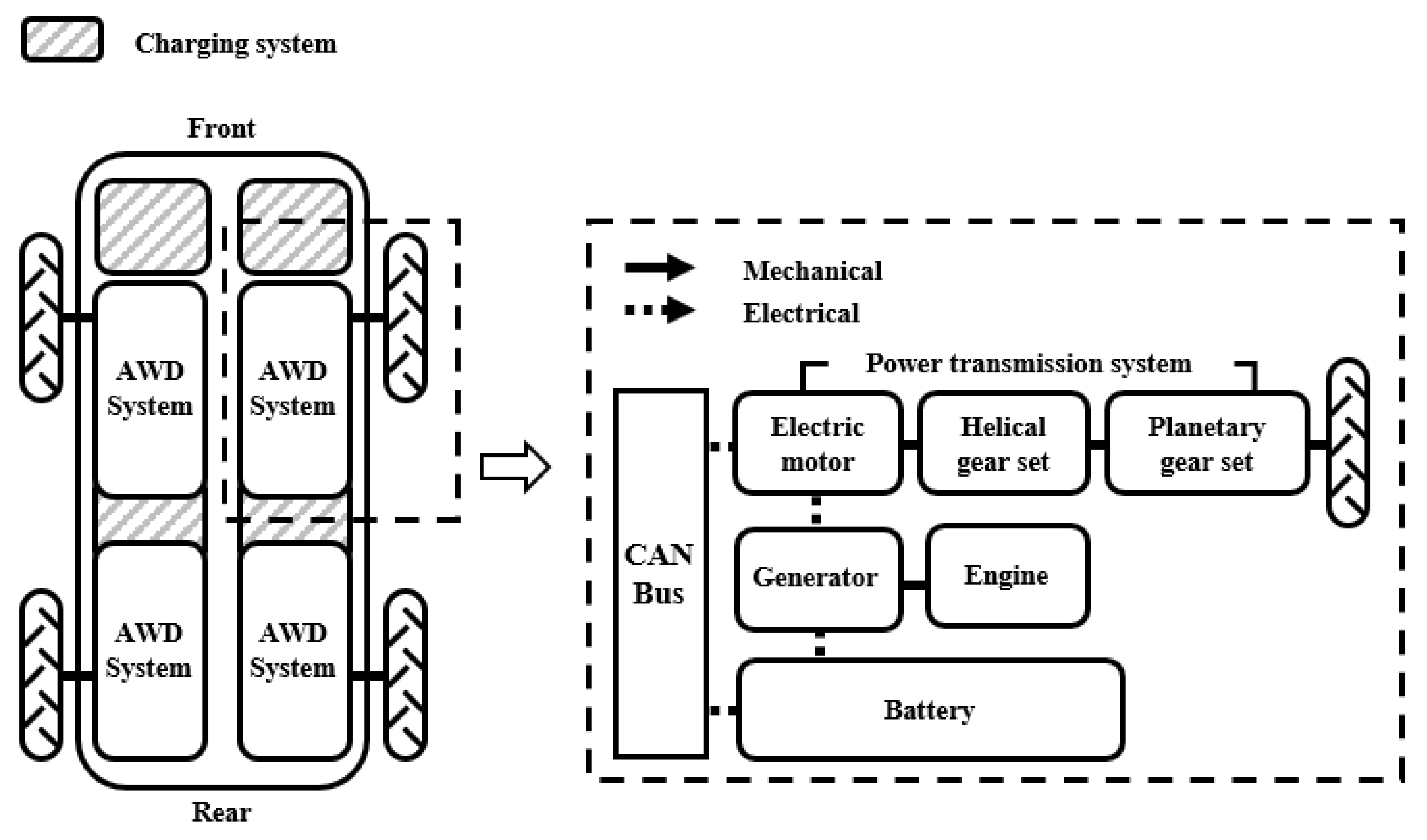

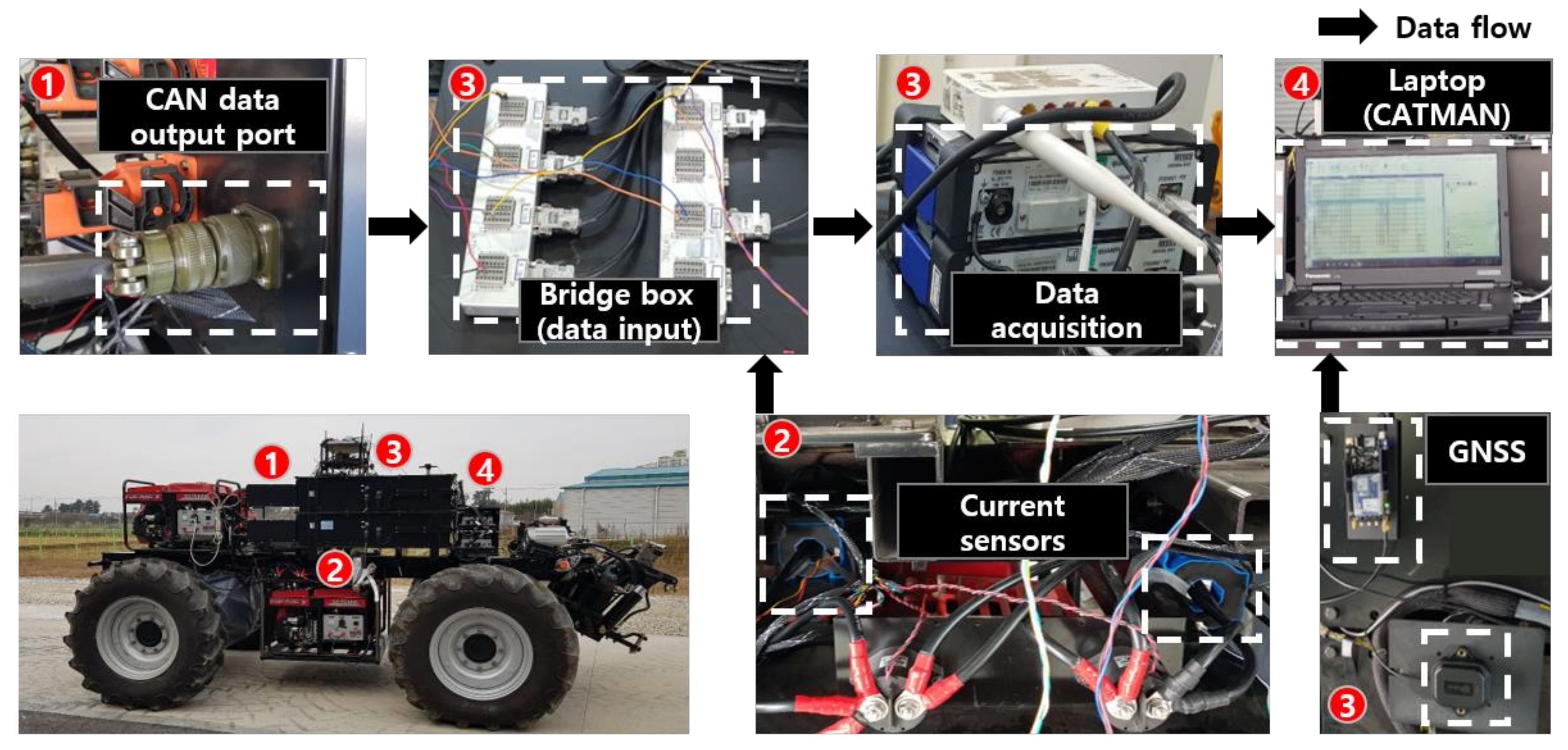


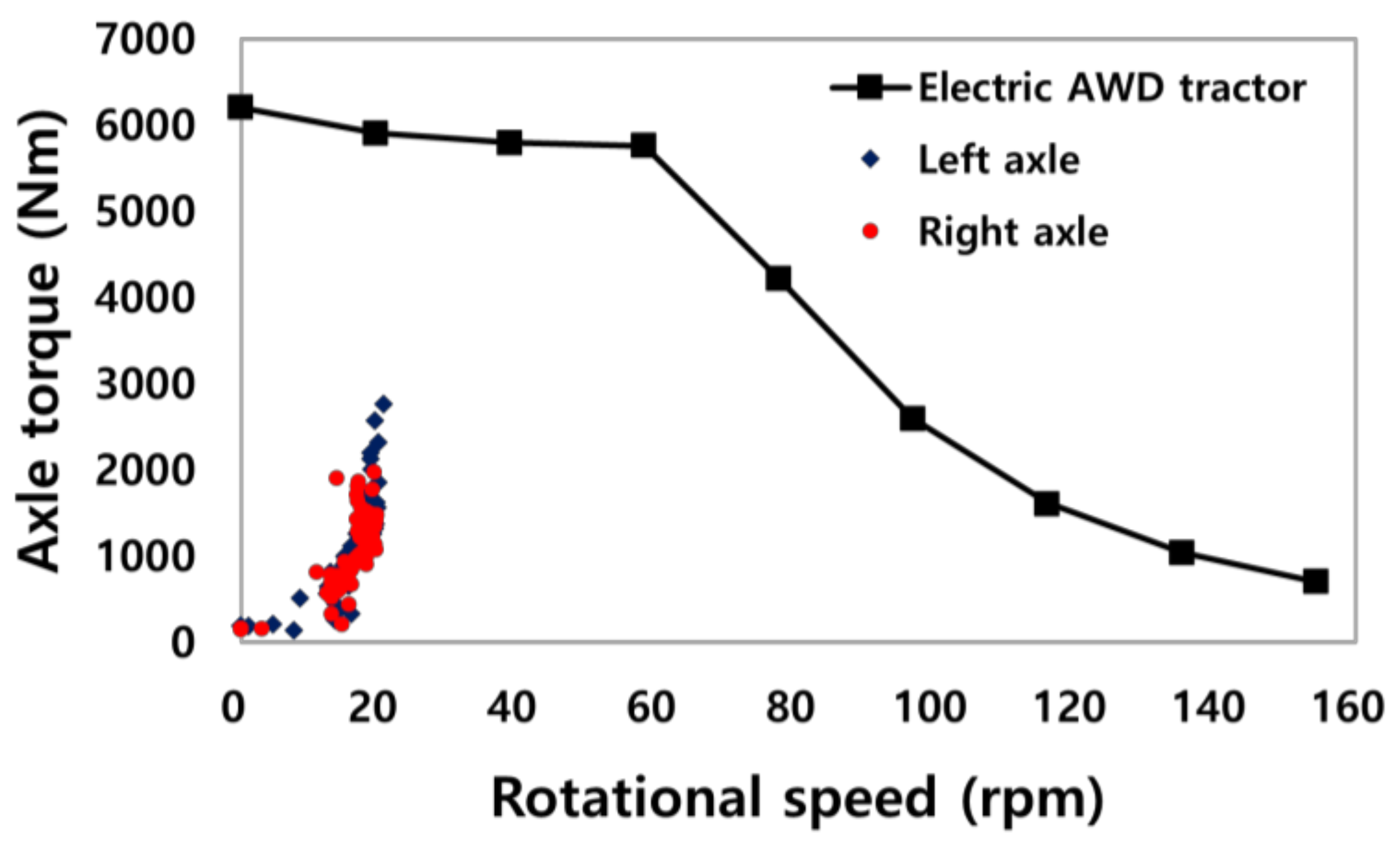
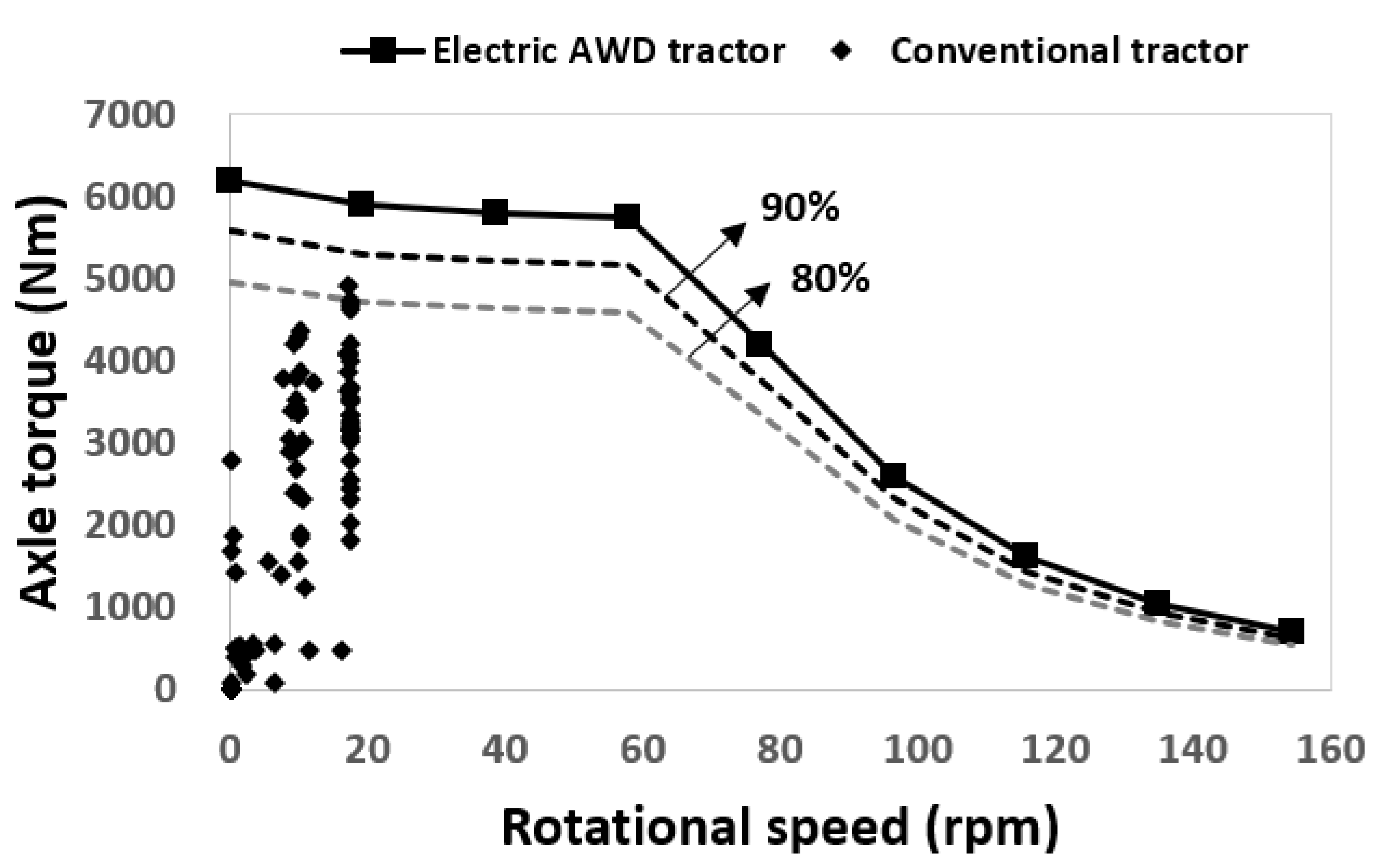
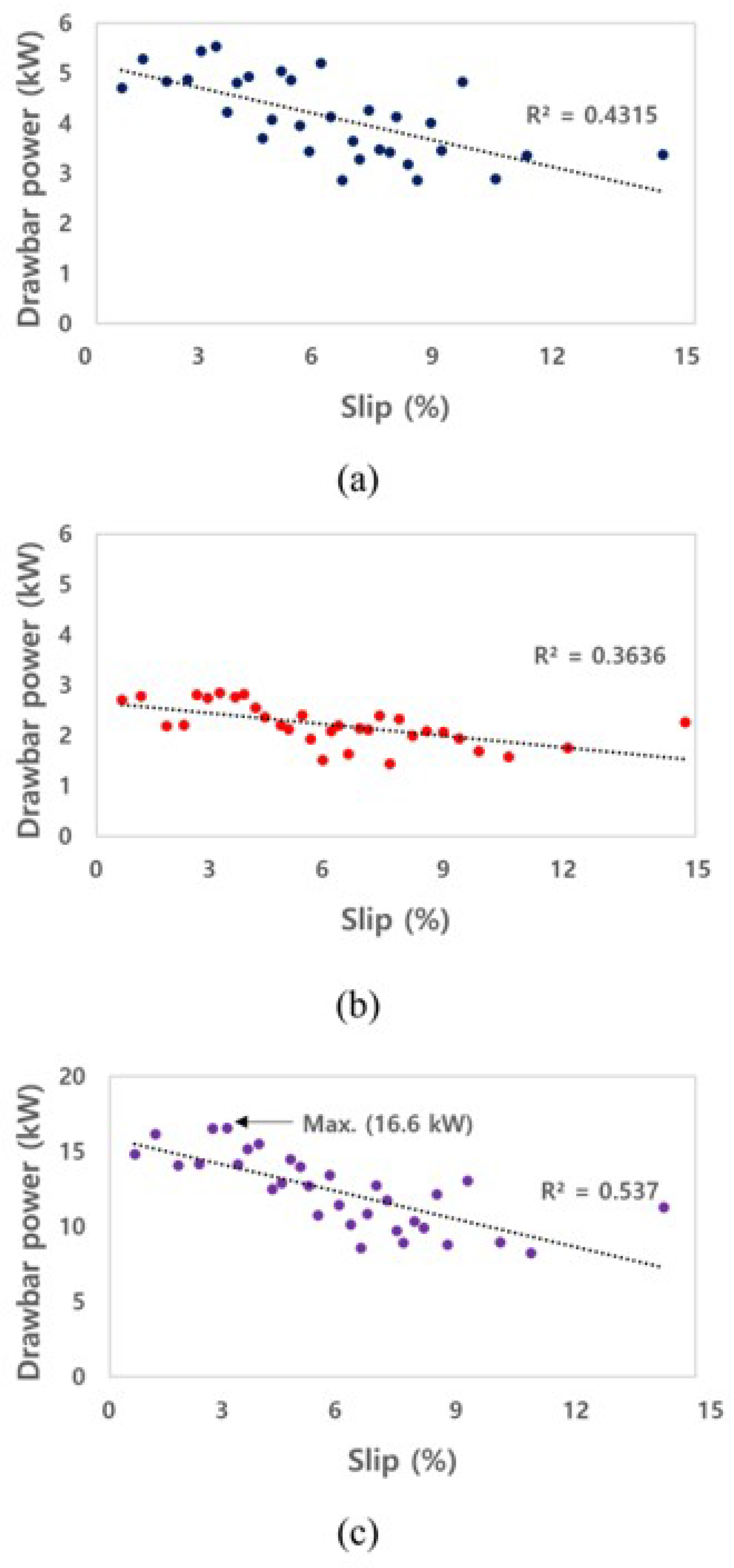
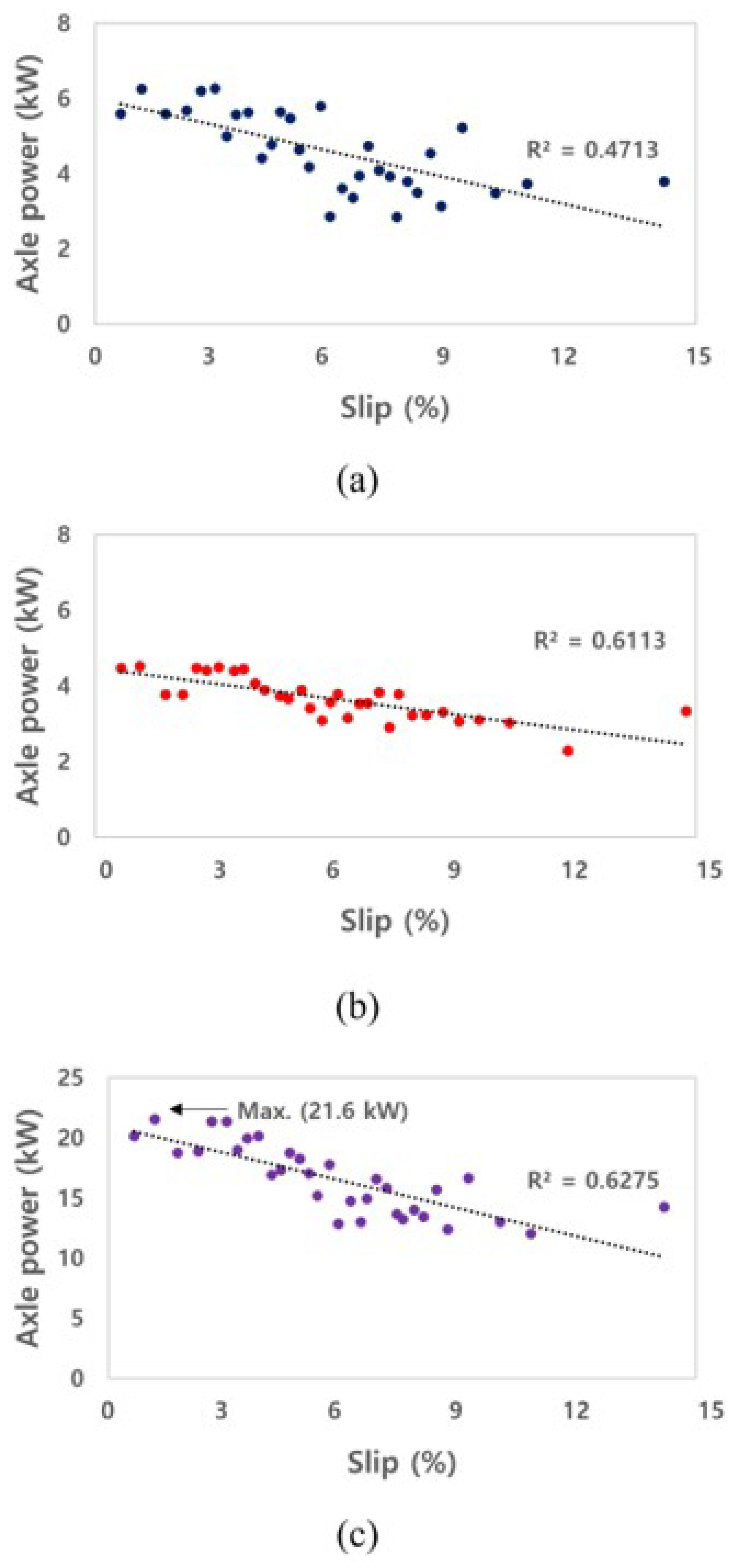

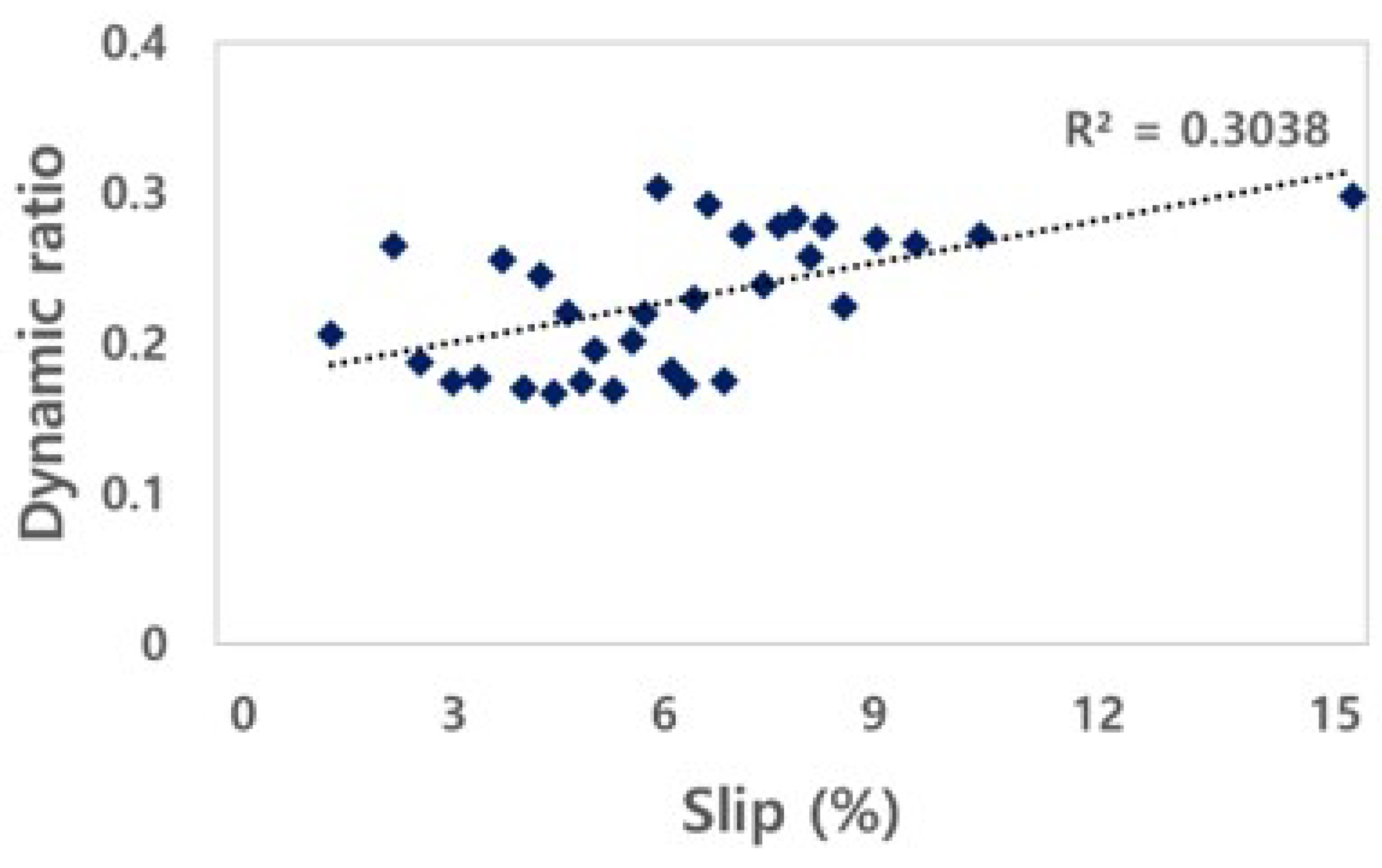
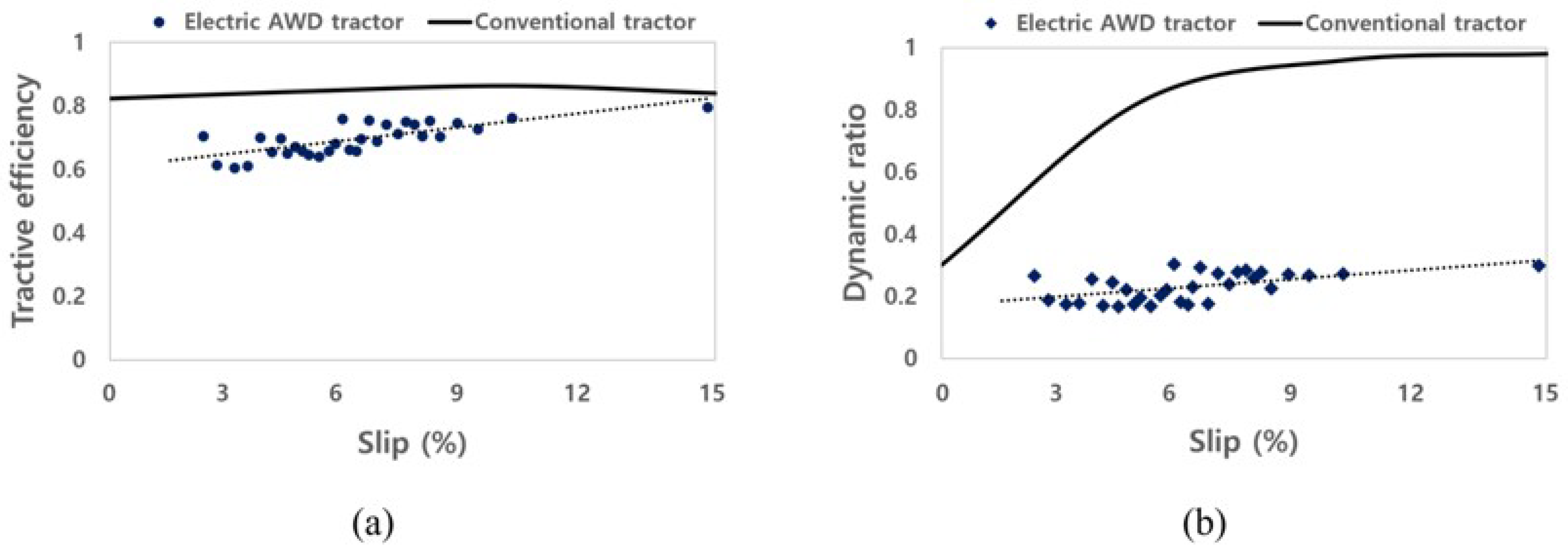
| Item | Specifications | |
|---|---|---|
| Length × Width × Height (mm3) | 5500 × 2500 × 1950 | |
| Mass (kg) | 7440 | |
| Electric motor | Max. torque (Nm) | 119.7 |
| Max. rotational speed (rpm) | 8000 | |
| Max. power (kW) | 37 | |
| Battery | Capacity (kWh) | 58.4 |
| Type | LiFePO4 | |
| Voltage (V)/C-Rate (C) | 70.4/2 | |
| Reducer | Planetary gear ratio | 12.05 |
| Helical gear ratio | 4.3 | |
| Tire | 380/85R24 | |
| Generator | Rated power (kW) | 13.5 |
| Charger | Max. output current (A) | 50 |
| Item | Specifications |
|---|---|
| Company | HBM |
| Model | QuantumX MX840B |
| Length × Width × Height (mm3) | 52.5 × 200 × 121 |
| Accuracy class (%) | 0.05–0.1 |
| Operating temperature (°C) | −20–65 |
| Number of channels | 8 |
| Max. sample rate per channel (kS·s−1) | 40 |
| Item | Specifications | |
|---|---|---|
| Tractor | Company | LS Mtron Ltd. |
| Model | LS1404 | |
| Length × Width × Height (mm3) | 4482 × 2320 × 3098 | |
| Mass (kg) | 6080 | |
| Rated power of engine (kW) | 112.3 @ 1799 rpm | |
| Moldboard plow | Company | Woongjin |
| Model | WJR4PS | |
| Length × Width × Height (mm3) | 3410 × 2120 × 1530 | |
| Mass (kg) | 930 | |
| Operating condition | Travel speed (km/h) | 4.09 |
| Working depth (cm) | 17–20 | |
| Soil environment | Cone index (kPa) | 1115 |
| Water content (% dry basis) | 24.6 | |
Publisher’s Note: MDPI stays neutral with regard to jurisdictional claims in published maps and institutional affiliations. |
© 2022 by the authors. Licensee MDPI, Basel, Switzerland. This article is an open access article distributed under the terms and conditions of the Creative Commons Attribution (CC BY) license (https://creativecommons.org/licenses/by/4.0/).
Share and Cite
Baek, S.-Y.; Baek, S.-M.; Jeon, H.-H.; Kim, W.-S.; Kim, Y.-S.; Sim, T.-Y.; Choi, K.-H.; Hong, S.-J.; Kim, H.; Kim, Y.-J. Traction Performance Evaluation of the Electric All-Wheel-Drive Tractor. Sensors 2022, 22, 785. https://doi.org/10.3390/s22030785
Baek S-Y, Baek S-M, Jeon H-H, Kim W-S, Kim Y-S, Sim T-Y, Choi K-H, Hong S-J, Kim H, Kim Y-J. Traction Performance Evaluation of the Electric All-Wheel-Drive Tractor. Sensors. 2022; 22(3):785. https://doi.org/10.3390/s22030785
Chicago/Turabian StyleBaek, Seung-Yun, Seung-Min Baek, Hyeon-Ho Jeon, Wan-Soo Kim, Yeon-Soo Kim, Tae-Yong Sim, Kyu-Hong Choi, Soon-Jung Hong, Hyunggun Kim, and Yong-Joo Kim. 2022. "Traction Performance Evaluation of the Electric All-Wheel-Drive Tractor" Sensors 22, no. 3: 785. https://doi.org/10.3390/s22030785
APA StyleBaek, S.-Y., Baek, S.-M., Jeon, H.-H., Kim, W.-S., Kim, Y.-S., Sim, T.-Y., Choi, K.-H., Hong, S.-J., Kim, H., & Kim, Y.-J. (2022). Traction Performance Evaluation of the Electric All-Wheel-Drive Tractor. Sensors, 22(3), 785. https://doi.org/10.3390/s22030785








